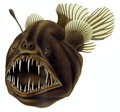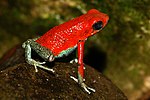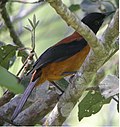species unprofitable enough to predators to allow Müllerian mimicry to develop. Once a pair of Müllerian mimics has formed, other mimics may join them by...
33 KB (3,605 words) - 12:10, 9 August 2024
warning coloration and mimicry VII — Evolutionary consequences of a Batesian–Müllerian spectrum: A model for Müllerian mimicry". Evolution. 30 (1): 86–93...
70 KB (7,695 words) - 16:57, 21 November 2024
form of protective mimicry is Müllerian mimicry, discovered by and named after the naturalist Fritz Müller. In Müllerian mimicry, both model and mimic...
29 KB (3,287 words) - 18:02, 15 October 2024
history of the Atlantic forest and was an early advocate of Darwinism. Müllerian mimicry is named after him. Müller was born in the village of Windischholzhausen...
11 KB (1,352 words) - 03:29, 5 November 2024
David B. (June 1991). "Revising a Classic Butterfly Mimicry Scenario: Demonstration of Müllerian Mimicry between Florida Viceroys (Limenitis archippus floridensis)...
22 KB (2,613 words) - 21:52, 3 August 2024
Müllerian may refer to: Müllerian mimicry, a type of mimicry or convergence named after Fritz Müller Müllerian ducts, which enter the cloaca of an embryo...
372 bytes (77 words) - 13:20, 21 September 2021
Danaus chrysippus (section Müllerian mimicry)
then attempt to eat the similar-looking unpalatable butterflies. Müllerian mimicry occurs when multiple species which are all unpalatable evolve to resemble...
35 KB (3,462 words) - 00:29, 28 October 2024
Batesian and Müllerian forms of mimicry, where the mimic shares outward characteristics with an aposematic or harmful model. In Batesian mimicry, the mimic...
43 KB (5,027 words) - 17:26, 25 November 2024
Aposematism (section Mimicry)
Wallace's concept of warning coloration. Aposematism is exploited in Müllerian mimicry, where species with strong defences evolve to resemble one another...
52 KB (5,673 words) - 00:23, 20 October 2024
protective Müllerian mimicry. Harmless insects such as hoverflies often derive protection from resembling bumblebees, in Batesian mimicry, and may be...
108 KB (11,622 words) - 06:37, 18 November 2024
Mutillidae have eight phenotypically distinct and geographically limited Müllerian mimicry rings (Desert, Eastern, Madrean, Texan, Red-headed Timulla, Black-headed...
20 KB (2,260 words) - 21:08, 20 November 2024
appears to use Müllerian mimicry for protection. It is hypothesized that this venom may have allowed it to develop a system of Müllerian mimicry with the Indian...
27 KB (3,371 words) - 15:36, 13 August 2024
ismenius resembles a number of other butterflies, an example of Müllerian mimicry. Like any other butterfly, Heliconius ismenius start as eggs, grow...
7 KB (685 words) - 21:00, 7 August 2024
Heliconius melpomene (section Mimicry)
a warning to predators of its inedibility; this is an example of Müllerian mimicry. H. melpomene was one of the first butterfly species observed to forage...
28 KB (3,235 words) - 15:02, 9 November 2024
Batesian mimicry, where the mimic is harmless and is essentially bluffing, and Müllerian mimicry, where the mimic is also distasteful, and the mimicry can...
63 KB (6,795 words) - 15:21, 20 November 2024
ant mimicry. Chemical mimicry exists within many of the different forms of mimicry such as aggressive, protective, Batesian, and Müllerian mimicry and...
11 KB (1,398 words) - 23:53, 3 January 2024
Defense in insects (category Mimicry)
context of geographic sympatry. Mimicry is divided into two parts, Batesian mimicry and Müllerian mimicry. In Batesian mimicry, an aposematic inedible model...
34 KB (4,153 words) - 07:52, 13 July 2024
led to suggestions that they and some species of chrysomelids form Müllerian mimicry rings particularly to defend them from birds. Despite their chemical...
54 KB (5,555 words) - 22:05, 29 October 2024
Heliconius erato (section Müllerian mimicry)
Linnaeus in his 1758 10th edition of Systema Naturae. H. erato exhibits Müllerian mimicry with other Heliconius butterflies such as Heliconius melpomene in...
26 KB (3,037 words) - 11:06, 22 November 2024
Monarch butterfly (section Mimicry)
actually more unpalatable than the monarch, making this a case of Müllerian mimicry. The monarch is the state insect of Alabama, Idaho, Illinois, Minnesota...
218 KB (21,348 words) - 22:48, 25 November 2024
Cleaning symbiosis (redirect from Mimicry among cleaner fish)
evolution. Mutual resemblance among cleaner fish is analogous to Müllerian mimicry, as where stinging bees and wasps mimic each other. In his Histories...
27 KB (2,420 words) - 07:47, 18 November 2024
survival advantage by resembling inedible species (the models). In Müllerian mimicry, inedible species, such as of wasps and bees, resemble each other...
134 KB (12,787 words) - 00:37, 7 October 2024
unpalatable red-bodied swallowtails, the common rose and the crimson rose. Müllerian mimicry occurs when aposematic species evolve to resemble each other, presumably...
101 KB (9,818 words) - 02:37, 25 November 2024
Heliconius sapho (section Müllerian mimicry)
hewitsoni Costa Rica H. s. leuce Costa Rica H. sapho engages in Müllerian mimicry with fellow Lepidoptera member H. cydno. The coloring pattern of H...
4 KB (360 words) - 21:19, 7 August 2024
Lithodytes (section Müllerian mimicry)
the shared color patterns between these two species, resulting in Müllerian mimicry. Analysis of anuran skin secretion chemical composition is important...
26 KB (3,124 words) - 07:59, 15 September 2024
and this resemblance should be considered as a case of Müllerian mimicry. In Müllerian mimicry, inedible species, usually within a taxonomic order, find...
155 KB (16,853 words) - 17:40, 18 November 2024
Euploea core (section Mimicry and similar species)
butterflies (see Batesian mimicry). In addition, the Indian species of the genus Euploea show another kind of mimicry, Müllerian mimicry. Accordingly, this species...
23 KB (2,467 words) - 21:42, 1 September 2024
evolution and Müllerian mimicry. Their appearance is also mimicked by unrelated non-poisonous species, a phenomenon known as Batesian mimicry. The toxic...
30 KB (3,612 words) - 10:11, 24 September 2024
insects exhibit protective mimicry of aggressive, stinging yellowjackets; in addition to numerous bees and wasps (Müllerian mimicry), the list includes some...
16 KB (1,754 words) - 12:54, 25 November 2024























